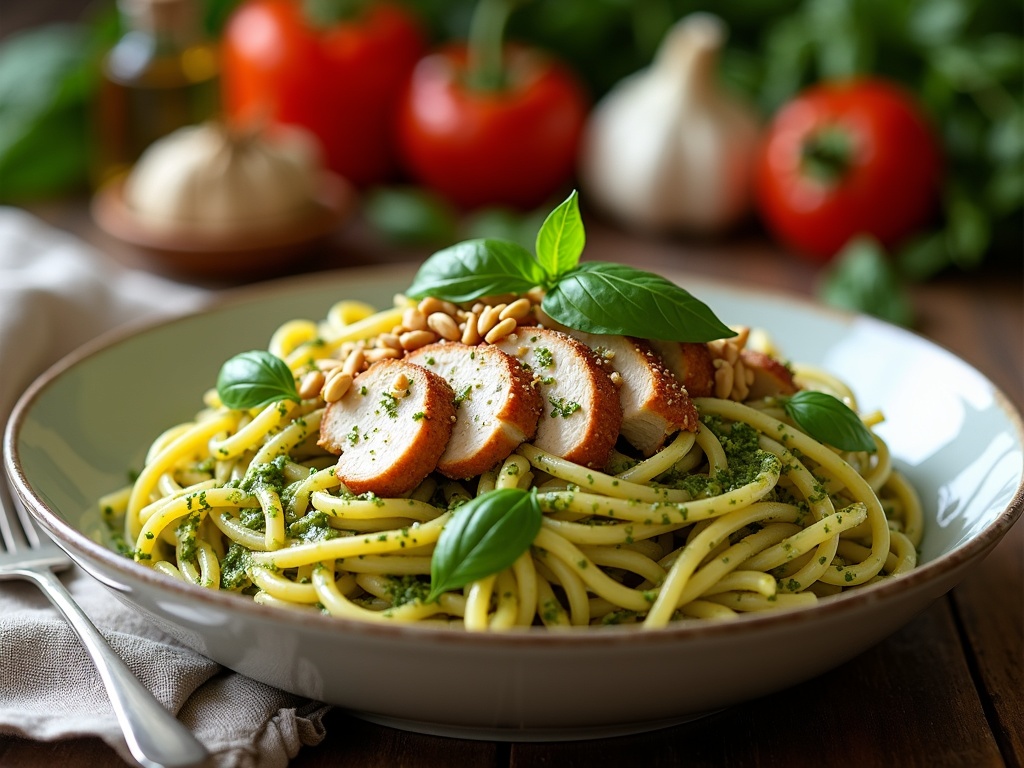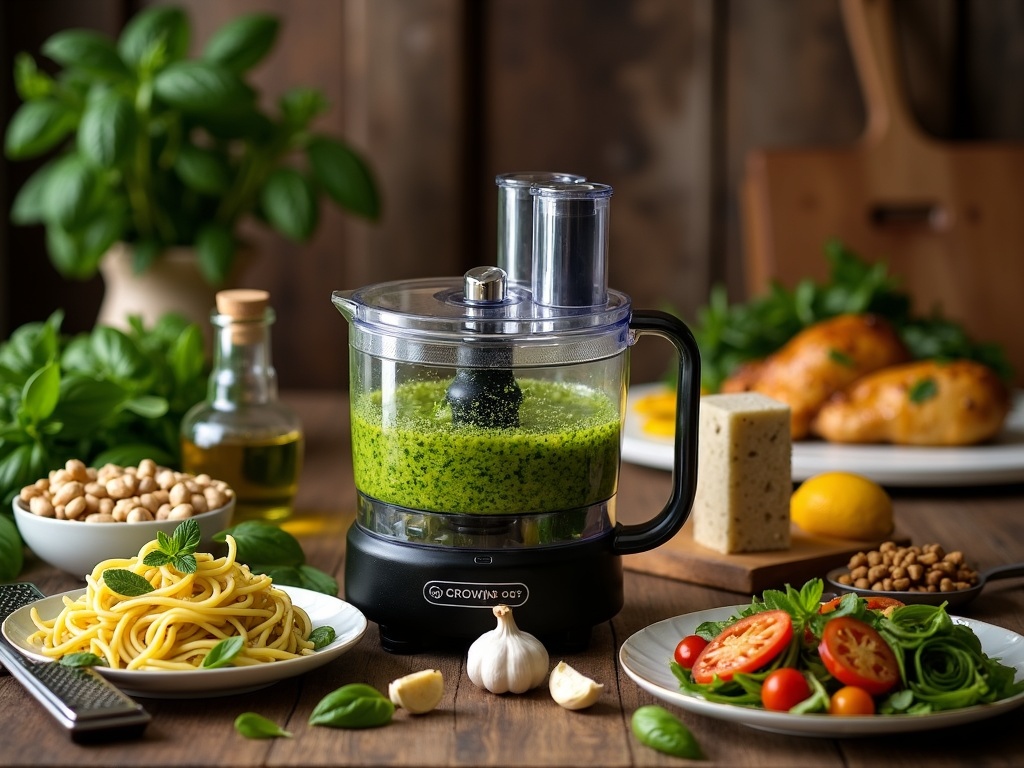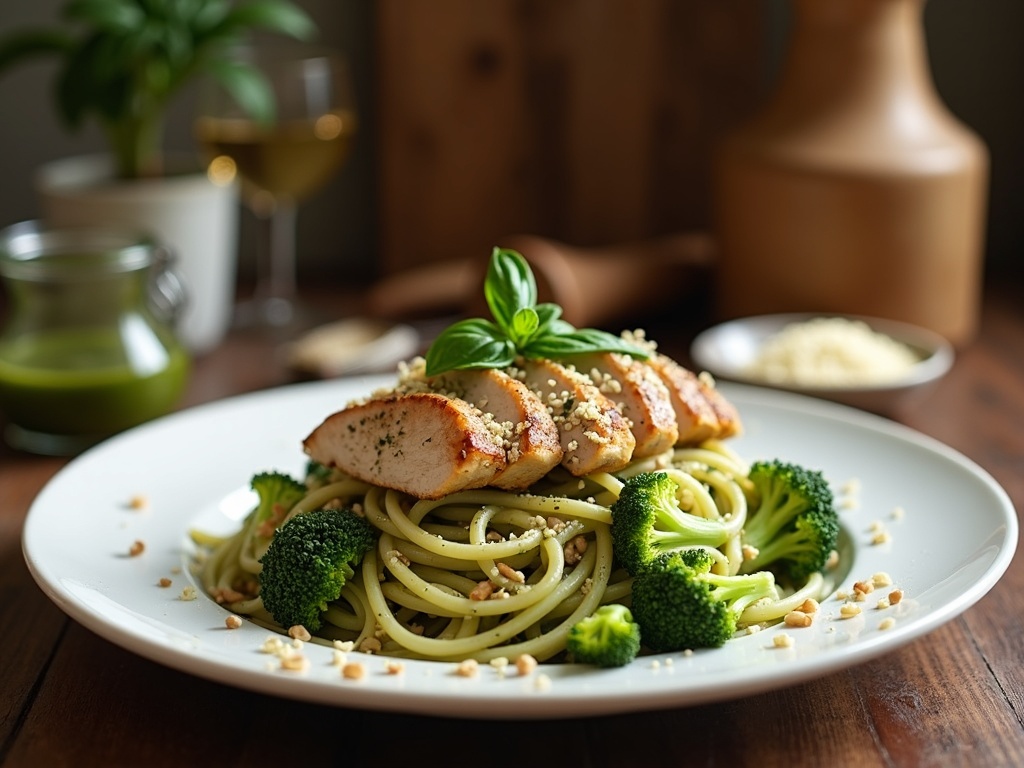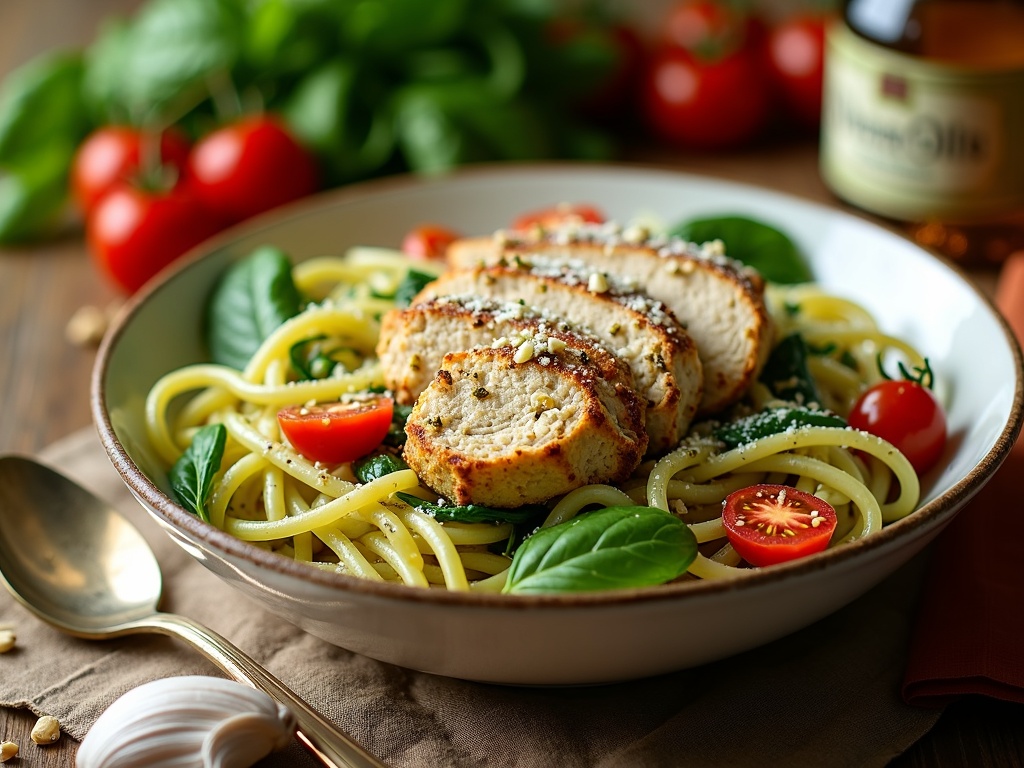Pesto chicken pasta combines convenience, affordability, and nutrition into one satisfying meal that I can prepare in under 30 minutes for the whole family. This versatile dish costs just $10-15 for four servings at home compared to $15-25 per serving at restaurants, making it both economical and delicious for busy weeknights.
Find In This Article
Key Takeaways
- A typical serving contains 450-600 calories with 25-30g of protein from chicken, complex carbohydrates from pasta, and healthy fats from olive oil and pine nuts.
- The meal comes together in just 15-30 minutes, making it perfect for busy weeknights or meal prep (stores well for 3-4 days).
- Homemade pesto costs only $2-3 per batch compared to $5-7 for store-bought jars and offers superior flavor and customization options.
- The dish is highly adaptable—use different nuts, add vegetables like broccoli or spinach, or create dairy-free versions with nutritional yeast.
- Save money by buying chicken in family packs, substituting expensive pine nuts with walnuts or sunflower seeds, and adding vegetables to stretch the meal further.
Why Pesto Chicken Pasta is Your Next Go-To Meal
Finding meals that balance cost, convenience, and nutrition can be challenging. I’ve discovered that homemade pesto pasta with chicken hits all these marks, making it an ideal weeknight solution for busy households.
Budget-Friendly Cooking
Pesto chicken pasta isn’t just delicious—it’s economical. When prepared at home, this complete meal costs approximately $10-15 for four generous servings. Compare that to restaurant versions that typically run $15-25 per single serving, and the savings become obvious. For a family of four, that’s potentially saving $50-85 in just one meal!
The cost efficiency comes from:
- Basic pasta (pennies per serving)
- Chicken breast (the most expensive component, but still affordable when purchased in family packs)
- Pesto ingredients (basil, pine nuts, parmesan, olive oil, and garlic) that can be used across multiple meals
- Optional add-ins like cherry tomatoes or spinach that are inexpensive and boost nutritional value
With grocery prices continuing to rise, finding meals that stretch your dollar without sacrificing quality matters more than ever.
Time-Saving Solution
I’ve found few meals match the speed-to-satisfaction ratio of pesto chicken pasta. From start to finish, this complete meal comes together in just 15-30 minutes, depending on your preparation method. This makes it perfect for:
- Busy weeknights when time is limited
- Last-minute dinner solutions when plans change
- Meal prep Sundays (it stores beautifully for 3-4 days)
The efficiency comes from simple cooking techniques. While pasta boils, I can prepare the chicken and mix the pesto, allowing everything to finish almost simultaneously. For even quicker preparation, using leftover simple chicken breast from another meal or pre-made pesto cuts the time even further.
If you’re managing a hectic schedule, having this recipe in your regular rotation means never being more than 30 minutes away from a satisfying homemade meal.
Nutritional Powerhouse
What impresses me most about pesto chicken pasta is how it delivers a complete nutritional package in one bowl. A typical 1.5 cup serving contains:
- 450-600 calories (adjustable based on portion size)
- Quality protein from chicken (25-30g per serving)
- Complex carbohydrates from pasta
- Healthy fats from olive oil and pine nuts
- Vitamins and minerals from fresh basil and any added vegetables
The dish is highly customizable to meet different nutritional needs. For a lighter version, I might use less pasta and more vegetables. For a protein boost after workouts, I’ll add extra chicken. The broccoli pasta variation adds significant fiber and vitamins with minimal additional effort.
Unlike many creamy pasta dishes that rely heavily on butter and cream, pesto-based sauces derive their richness from olive oil—a heart-healthy fat source that supports good cholesterol levels.
When looking for a balanced meal that satisfies both taste buds and nutritional needs, pesto chicken pasta delivers consistently. Its popularity on social media under hashtags like #PestoChickenPasta, #HealthyEating, and #PastaRecipes reflects its growing status as a smart meal solution.
Whether you’re making a simple version with store-bought pesto or creating an elevated chicken recipe with homemade sauce, this dish offers remarkable versatility. For a creamier alternative that still maintains the herb-forward profile, try a white sauce pasta recipe with pesto stirred in at the end.
With its perfect balance of cost, convenience, and nutrition, pesto chicken pasta deserves a place in your regular meal rotation.
Essential Nutritional Benefits
A hearty bowl of pesto chicken pasta offers more than just delicious flavor – it’s also a powerhouse of balanced nutrition. I’ve discovered that this dish creates a perfect harmony of macronutrients and essential vitamins that can fuel your body effectively.
Balanced Macronutrients
The combination of ingredients in pesto chicken pasta delivers an impressive nutritional profile. Each serving provides approximately 30-35g of high-quality protein from chicken breast, which supports muscle maintenance and growth. This makes it an excellent post-workout meal or a satisfying dinner option for active individuals.
The pasta component contributes 60-70g of carbohydrates, providing the energy your body needs for daily activities. These carbs serve as your primary fuel source, especially important if you lead an active lifestyle.
The pesto sauce adds 15-25g of healthy fats, primarily from olive oil and nuts. These fats aren’t just flavorful – they help with nutrient absorption and provide sustained energy. The olive oil in traditional pesto contains heart-healthy monounsaturated fats that can support cardiovascular health.
Micronutrient Advantages
Beyond the macronutrients, this dish offers several valuable micronutrients:
- Vitamin E from pine nuts and olive oil acts as a powerful antioxidant
- B vitamins from chicken breast support energy metabolism
- Iron from both pasta and chicken helps maintain healthy blood cells
- Calcium from cheese in pesto contributes to bone health
- 3-7g of dietary fiber (varying based on pasta type) aids digestion
For a nutrient boost, I often add vegetables to my broccoli pasta dishes. Using whole grain pasta instead of refined options increases the fiber content significantly.
The pesto recipe itself delivers concentrated nutrition through its ingredients. Traditional basil pesto contains antioxidants from fresh herbs, while the pine nuts provide magnesium and zinc. For a protein-packed meal, I recommend pairing it with simple chicken breast recipes that don’t overpower the pesto flavor.
For those seeking a creamier variation, combining pesto with a white sauce pasta recipe creates a rich flavor while still delivering substantial nutrition. The marry me chicken recipe approach adds sun-dried tomatoes for additional antioxidants and flavor dimension.
The beauty of creamy pasta with pesto and chicken is that it satisfies cravings while providing complete nutrition in a single dish – making it both a practical and nutritious choice for busy weeknights.

Master the Perfect Pesto at Home
Making your own pesto is a game changer for any homemade pesto recipe enthusiast. I’ve found that once you nail the basics, this versatile sauce can transform simple dishes into memorable meals.
Essential Pesto Recipe and Variations
The classic pesto recipe is remarkably straightforward. You’ll need just five key ingredients: 2 cups of fresh basil leaves, 2 garlic cloves, 1/2 cup of pine nuts, 1/2 cup of freshly grated Parmesan cheese, and 1/2 cup of quality olive oil. Blend these together until smooth, and you’ve got an authentic pesto that’s miles better than anything you’ll find in a jar.
What makes homemade pesto so fantastic is its adaptability. Don’t have pine nuts on hand? No problem! Try these alternatives:
- Walnuts or almonds make excellent substitutes for pine nuts at a fraction of the cost
- Spinach can replace some or all of the basil for a milder flavor
- Nutritional yeast works beautifully instead of Parmesan for a dairy-free option
- Fresh lemon zest adds brightness to your sauce
I’ve experimented with these variations when making pesto chicken pasta and found that each brings something unique to the dish. The spinach version pairs exceptionally well with simple chicken breast recipes, while the walnut variation adds earthiness that complements broccoli pasta beautifully.
Homemade pesto isn’t just tastier than store-bought—it’s also significantly cheaper. While a small jar at the supermarket can cost $5-7, making it yourself runs about $2-3 per batch, which typically yields enough for 3-4 meals. Plus, you can adjust the ingredients to suit your dietary needs, whether you’re looking for low-sodium, dairy-free, or nut-free options.
The difference in flavor is remarkable too. Fresh basil delivers bright, aromatic notes that bottled pestos can’t match. I’ve served my homemade pesto alongside store-bought versions in white sauce pasta recipes for comparison, and guests consistently prefer the homemade version.
For a quick weeknight dinner, I often whip up a batch to toss with pasta and roasted chicken. It’s also perfect stirred into creamy pasta dishes for added depth, or used as a marinade for marry me chicken recipe variations.
The best part? Homemade pesto freezes beautifully. I pour extra pesto into ice cube trays, freeze them, then store the cubes in freezer bags. This way, I always have perfect portions ready to enliven any meal in minutes.
Getting the texture right takes a bit of practice. I aim for a consistency that’s smooth but not completely puréed—those tiny flecks of basil and nuts add character to your finished dish. Just pulse your food processor rather than running it continuously for the perfect texture.
By mastering this simple sauce, you’ll elevate countless meals with minimal effort. The vibrant color, fresh flavor, and customizable nature of homemade pesto make it worth the five minutes it takes to prepare.

Cook It Like a Pro
Ready to take your homemade pesto chicken pasta to the next level? I’ve perfected this dish through years of trial and error, and I’m excited to share my top cooking techniques that will transform this simple meal into a restaurant-quality experience.
Pasta Perfection
The foundation of any great pasta dish starts with perfectly cooked noodles. I fill a large pot with water (about 4 quarts for a pound of pasta) and add a generous tablespoon of salt—this isn’t just for flavor, it actually changes the texture of your pasta for the better.
Once the water reaches a rolling boil, I add the pasta and stir immediately to prevent sticking. For most pasta shapes like penne or fusilli that pair beautifully with creamy pasta sauces and pesto, 8-10 minutes is the sweet spot. However, I always test a piece about a minute before the package suggests—you’re looking for that perfect “al dente” texture with just a hint of firmness in the center.
A pro tip: save about half a cup of pasta water before draining. This starchy liquid is liquid gold for bringing together your white sauce pasta or pesto sauce later.
Chicken Mastery
While the pasta cooks, I focus on creating juicy, flavorful chicken that will elevate the entire dish. I start with boneless, skinless chicken breasts and slice them into even-thickness cutlets by butterflying thicker pieces. This ensures quick, even cooking.
I season the chicken generously with salt, pepper, and Italian herbs before cooking. For the best results:
- Preheat your grill pan or skillet over medium-high heat
- Add a thin layer of olive oil to prevent sticking
- Place the chicken cutlets without crowding the pan
- Cook undisturbed for 6-7 minutes on the first side
- Flip once and cook 5-6 minutes on the second side
- Use a meat thermometer to verify 165°F internal temperature
The total cooking process typically takes 15-30 minutes from start to finish, making this simple chicken breast recipe perfect for busy weeknights.
I’ve learned that allowing the chicken to rest for 5 minutes before slicing makes a huge difference in juiciness. During this time, I toss the drained pasta with fresh pesto sauce, adding a splash of that reserved pasta water to create a silky consistency.
For an even more impressive presentation, try adding some broccoli pasta elements by tossing in some blanched florets. The bright green color creates a beautiful contrast against the pesto.
When plating, I slice the chicken diagonally and arrange it artfully over the pasta. A sprinkle of toasted pine nuts and freshly grated Parmesan completes this elegant yet simple dish that rivals your favorite marry me chicken recipe for impressive results.
Whether cooking for a family dinner or a special date night, these professional techniques guarantee a crowd-pleasing meal that looks and tastes like it came from a high-end Italian restaurant.

Budget-Friendly Shopping Guide
Making pesto chicken pasta doesn’t have to break the bank. I’ve broken down the costs to show you just how affordable this delicious meal can be for your family.
Core Ingredients Breakdown
Pasta forms the foundation of this dish, typically costing between $1-2 for a standard 16oz box. I find that penne, fusilli, or farfalle work wonderfully with homemade pesto, catching all that herbaceous goodness in their shapes.
Chicken breast usually ranges from $5-8 per pound, depending on whether you buy organic or conventional. You can stretch your dollar by purchasing family packs and freezing portions for later use. For a budget-friendly alternative, consider using simple chicken recipes with thighs which often cost less but offer more flavor.
Making your own pesto saves significant money compared to store-bought options. The basic ingredients (basil, garlic, pine nuts, olive oil, and cheese) can cost as little as $2-3 for a batch when bought in season. Pro tip: substitute costly pine nuts with walnuts or even sunflower seeds to reduce expenses further.
Money-Saving Enhancements
Adding vegetables not only boosts nutrition but stretches your meal further:
- Broccoli ($1-1.50): Adds vibrant color and pairs beautifully with the broccoli pasta combination
- Spinach ($1-2): Wilts down easily and increases volume
- Cherry tomatoes ($1.50-2): Provides bursts of flavor
- Zucchini ($1-1.50): Bulks up the dish inexpensively
The total cost for a meal serving 4-6 people typically lands between $10-15, making this creamy pasta dish remarkably economical at $2.50-$3.75 per portion.
I’ve found that making marry me chicken variations with pesto can be equally affordable and adds a romantic touch to date nights without the restaurant price tag.
For maximum savings, look for sales on chicken, buy herbs from farmers’ markets when in season, or grow your own basil. Pasta frequently goes on sale, so stock up when prices drop. Your white sauce pasta recipe can be alternated with pesto versions to keep your menu exciting while maintaining budget-friendliness.
With these shopping strategies, you’ll create restaurant-quality meals at a fraction of the cost, proving that delicious, wholesome cooking doesn’t require a hefty investment.
Sources:
Healthline, Protein Needs: How Much Protein You Should Eat
U.S. Department of Agriculture, FoodData Central
Bon Appétit, Best Pesto Recipe
The Kitchn, Cost Analysis: Cooking at Home vs. Eating Out

